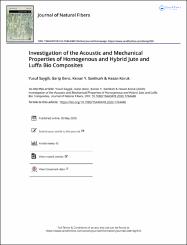Please use this identifier to cite or link to this item:
https://hdl.handle.net/20.500.11779/1326| Title: | Investigation of the Acoustic and Mechanical Properties of Homogenous and Hybrid Jute and Luffa Bio Composites |
| Authors: | Garip Genç Hasan Körük Kenan Y. Sanlıtürk Yusuf Saygılı |
| Keywords: | Sound absorption Jute Transmission loss Luffa Elastic properties Damping |
| Publisher: | Taylor & Francis |
| Source: | Saygili, Y. Genc, G., Sanliturk, Kenan Y. & Koruk, H. (2020), Investigation of the Acoustic and Mechanical Properties of Homogenous and Hybrid Jute and Luffa Bio Composites, Journal of Natural Fibers, DOI: 10.1080/15440478.2020.1764446. https://doi.org/10.1080/15440478.2020.1764446 |
| Abstract: | Design and development of new biomaterials has become a necessity due to adverse effects of chemical materials on people and nature. As the mechanical properties of biomaterials are not as good as those of chemical materials, their different configurations should be developed and tested before considering them for practical applications. Acoustic and mechanical properties of homogenous and hybrid jute and luffa biocomposites are investigated here. Homogenous and hybrid composites using jute and luffa fibers and epoxy are designed and manufactured and methods for identification of the acoustic and mechanical properties are summarized. Acoustic and structural frequency response functions are measured using homogenous and hybrid composite plates to determine their natural frequencies and loss factors. Using the experimental modal parameters of the plates and their theoretical models, elasticity moduli of biomaterials are determined. The acoustic absorption properties and transmission losses of homogeneous and hybrid composites are determined using impedance tube method. Results show that homogenous and hybrid jute and luffa composites can have moderate absorption coefficients (0.1 for a thickness of 4 mm) and superior damping performance of luffa and stiffness property of jute can be used together to produce hybrid composites with high damping (2.2–2.6%) and elasticity modulus (3–5 GPa). |
| URI: | https://doi.org/10.1080/15440478.2020.1764446 https://hdl.handle.net/20.500.11779/1326 |
| Appears in Collections: | Makine Mühendisliği Bölümü Koleksiyonu Scopus İndeksli Yayınlar Koleksiyonu / Scopus Indexed Publications Collection WoS İndeksli Yayınlar Koleksiyonu / WoS Indexed Publications Collection |
Files in This Item:
| File | Description | Size | Format | |
|---|---|---|---|---|
| HasanKoruk.pdf | Full Text - Article | 1.45 MB | Adobe PDF |  View/Open |
CORE Recommender
Sorry the service is unavailable at the moment. Please try again later.
This item is licensed under a Creative Commons License
